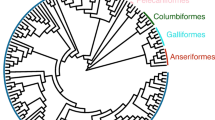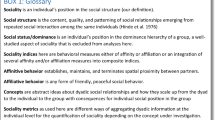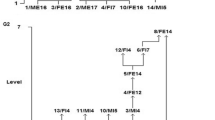Abstract
In animal societies, individuals face the dilemma of whether to cooperate or to compete over a shared resource. Two intertwined mechanisms may help to resolve this enduring evolutionary dilemma by preventing conflicts and thereby mediating the costs of living in groups: the establishment of dominance hierarchies and the use of ‘badge-of-status’ for signalling dominance. We investigated these two mechanisms in the sociable weaver (Philetairus socius), a colonial and social passerine which cooperates over multiple tasks. We examined the sociable weavers’ dominance structure in 2 years by recording 2563 agonistic interactions between 152 individuals observed at a feeder at eight colonies. We tested which individual traits, including sex, age, relatedness and two melanin-based plumage traits, predicted variation in social status. First, using social network analysis, we found that colonies were structured by strongly ordered hierarchies which were stable between years. Second, medium-ranked birds engaged more in aggressive interactions than highly ranking individuals, suggesting that competition over food is most pronounced among birds of intermediate social status. Third, we found that colony size and kinship influenced agonistic interactions, so aggression was less pronounced in smaller colonies and among relatives. Finally, within- and between-individual variation in social status and the presence of an individual at the feeder were associated with variation in bib size, as predicted by the badge-of-status hypothesis. These results suggest that dominance hierarchies and bib size mediate conflicts in sociable weaver societies.





Similar content being viewed by others
References
Anderholm S, Olsson M, Wapstra E, Ryberg K (2004) Fit and fat from enlarged badges: a field experiment on male sand lizards. Proc R Soc Lond B 271:S142–S144
Archie EA, Morrison TA, Foley CA, Moss CJ, Alberts SC (2006) Dominance rank relationships among wild female African elephants, Loxodonta africana. Anim Behav 71:117–127
Arnott G, Elwood RW (2009) Assessment of fighting abilities in animal contests. Anim Behav 77:991–1004
Aureli F, de Waal FBM (eds) (2000) Natural conflict resolution. University of California Press, Berkeley
Baan C, Bergmüller R, Smith DW, Molnar B (2014) Conflict management in free-ranging wolves (Canis lupus). Anim Behav 90:327–334
Barkan CPL, Craig JL, Strahl SD, Stewart AM, Brown JL (1986) Social dominance in communal Mexican jays (Aphelocoma ultramarina). Anim Behav 34:175–187
Barton K (2013) MuMIn: multi-model inference, R package version 1.9.5. http://CRAN.R-project.org/package=MuMIn. Accessed 6 Jun 2012
Bates D, Maechler M (2009) lme4: linear mixed-effects models using S4 classes. R package version 0.999375-32. http://CRAN.R-project.org/package=lme4. Accessed 6 Jun 2012
Bergeron P, Grignolio S, Apollonio M, Shipley B, Festa-Bianchet M (2010) Secondary sexual characters signal fighting ability and determine social rank in alpine ibex (Capra ibex). Behav Ecol Sociobiol 64:1299–1307
Bergstrom ML, Fedigan LM (2010) Dominance among female white-faced capuchin monkeys (Cebus capucinus): hierarchical linearity, nepotism, strength and stability. Behaviour 147:899–931
Blumstein DT, Steinmetz J, Kenneth B, Daniel JC (1997) Alarm calling in yellow-bellied marmots: II. The importance of direct fitness. Anim Behav 53:173–184
Bókony V, Garamszegi LZ, Hirschenhauser K, Liker A (2008) Testosterone and melanin-based black plumage coloration: a comparative study. Behav Ecol Sociobiol 62:1229–1238
Cant MA, Field J (2001) Helping effort and future fitness in cooperative animal societies. Proc R Soc Lond B 268:1959–1964
Cant MA, English S, Reeve HK, Field J (2006a) Escalated conflict in a social hierarchy. Proc R Soc Lond B 273:2977–2984
Cant MA, Llop JB, Field J (2006b) Individual variation in social aggression and the probability of inheritance: theory and a field test. Am Nat 167:837–852
Chase ID (1980) Social process and hierarchy formation in small groups: a comparative perspective. Am Sociol Rev 45:905–924
Chiarati E, Canestrari D, Vera R, Marcos JM, Baglione V (2010) Linear and stable dominance hierarchies in cooperative carrion crows. Ethology 116:346–356
Clutton-Brock TH, Brotherton PNM, O’Riain MJ, Griffin AS, Gaynor D, Sharpe L, Kansky R, Manser MB, McIlrath GM (2000) Individual contributions to babysitting in a cooperative mongoose, Suricata suricatta. Proc R Soc Lond B 267:301–305
Cockburn A (1998) Evolution of helping behavior in cooperatively breeding birds. Annu Rev Ecol Syst 29:141–177
Cotton S, Fowler K, Pomiankowski A (2004) Condition dependence of sexual ornament size and variation in the stalk‐eyed fly Cyrtodiopsis dalmanni (Diptera: Diopsidae). Evolution 58:1038–1046
Covas R, Brown CR, Anderson MD, Brown MB (2002) Stabilizing selection on body mass in the sociable weaver (Philetairus socius). Proc R Soc Lond B 269:1905–1909
Covas R, Dalecky A, Caizergues A, Doutrelant C (2006) Kin associations and direct vs indirect fitness benefits in colonial cooperatively breeding sociable weavers Philetairus socius. Behav Ecol Sociobiol 60:323–331
Covas R, du Plessis MA, Doutrelant C (2008) Helpers in colonial cooperatively breeding sociable weavers (Philetairus socius) contribute to buffer the effects of adverse breeding conditions. Behav Ecol Sociobiol 63:103–112
David HA (1987) Ranking from unbalanced paired-comparison data. Biometrika 74:432–436
de Vries H (1995) An improved test of linearity in dominance hierarchies containing unknown or tied relationships. Anim Behav 50:1375–1389
de Vries H (1998) Finding a dominance order most consistent with a linear hierarchy: a new procedure and review. Anim Behav 55:827–843
de Vries H, Stevens JMG, Vervaecke H (2006) Measuring and testing the steepness of dominance hierarchies. Anim Behav 71:585–592
R Development Core Team (2012) R: a language and environment for statistical computing. 2.15.0 edn. R Foundation for Statistical Computing, Vienna, Austria. http://CRAN.R-project.org. Accessed 9 Jan 2011
Dey CJ, Dale J, Quinn JS (2014) Manipulating the appearance of a badge of status causes changes in true badge expression. Proc R Soc Lond B 281:20132680
Dijkstra PD, van Dijk S, Groothuis TG, Pierotti ME, Seehausen O (2009) Behavioral dominance between female color morphs of a Lake Victoria cichlid fish. Behav Ecol 20:593–600
Dobson FS, Viblanc VA, Arnaud CM, Murie JO (2012) Kin selection in Columbian ground squirrels: direct and indirect fitness benefits. Mol Ecol 21:524–531
Ducrest AL, Keller L, Roulin A (2008) Pleiotropy in the melanocortin system, coloration and behavioural syndromes. Trends Ecol Evol 23:502–510
Ensminger AL, Meikle DB (2005) Effects of male kinship and agonistic behaviour on reproduction and odour preferences of female house mice, Mus domesticus. Anim Behav 69:1147–1155
Gammell MP, De Vries H, Jennings DJ, Carling CM, Hayden TJ (2003) David’s score: a more appropriate dominance ranking method than Clutton-Brock et al.’s index. Anim Behav 66:601–605
Green AJ (2001) Mass/length residuals: measures of body condition or generators of spurious results? Ecology 82:1473–1483
Griffiths C, Double MC, Orr K, Dawson RJG (1998) A DNA test to sex most birds. Mol Ecol 7:1071–1075
Hamilton WD (1964) The genetical evolution of social behaviour. I. J Theor Biol 7:1–16
Handcock MS, Hunter D, Butts CT, Goodreau SM, Morris M (2003) statnet: software tools for the statistical modeling of network data. http://CRAN.R-project.org/package=statnet. Accessed 6 Jun 2012
Herberholz J, McCurdy C, Edwards DH (2007) Direct benefits of social dominance in juvenile crayfish. Biol Bull 213:21–27
Huntingford F, Turner A (1987) Animal conflict. Chapman-Hall, London
Isbell LA, Young TP (2002) Ecological models of female social relationships in primates: similarities, disparitities and some directions for future clarity. Behaviour 139:177–202
Izawa EI, Watanabe S (2008) Formation of linear dominance relationship in captive jungle crows (Corvus macrorhynchos): implications for individual recognition. Behav Process 78:44–52
Jarvi T, Bakken M (1984) The function of the variation in the breast stripe of the great tit (Parus major). Anim Behav 32:590–596
Johnston RA (2000) Models of reproductive skew: a review and synthesis. Ethology 106:5–26
Karubian J, Lindsay WR, Schwabl H, Webster MS (2011) Bill coloration, a flexible signal in a tropical passerine bird, is regulated by social environment and androgens. Anim Behav 81:795–800
Kaufmann JH (1983) On the definitions and functions of dominance and territoriality. Biol Rev 58:1–20
Kendall MG (1962) Rank correlation methods, 3rd edn. Charles Griffin, London
Ketterson ED, Nolan V Jr (1992) Hormones and life histories: an integrative approach. Am Nat 140:S33–S62
Kodric-Brown A, Nicoletto PF (2001) Female choice in the guppy (Poecilia reticulata): the interaction between male color and display. Behav Ecol Sociobiol 50:346–351
Konovalov DA, Manning C, Henshaw MT (2004) KINGROUP: a program for pedigree relationship reconstruction and kin group assignments using genetic markers. Mol Ecol Notes 4:779–782
Kuznetsova A, Brockhoff PB, Christensen RHB (2014) lmerTest: tests for random and fixed effects for linear mixed effect models (lmer objects of lme4 package), R package version 2.0-6. http://CRAN.R-project.org/package=lmerTest. Accessed 12 Jun 2013
Landau HG (1951) On dominance relations and the structure of animal societies: I. Effect of inherent characteristics. Bull Math Biol 13:1–19
Laubach ZM, Blumstein DT, Romero ML, Foufopoulos J (2013) Are white-crowned sparrow badges reliable signals? Behav Ecol Sociobiol 67:481–492
Laucht S, Dale J (2012) Development of badges of status in captive male house sparrows (Passer domesticus) in relation to the relative ornamentation of flock-mates. Ethology 118:644–653
Liker A, Freckleton RP, Székely T (2013) The evolution of sex roles in birds is related to adult sex ratio. Nat Commun 4:1587
Maclean GL (1973a) The sociable weaver, part 1: description, distribution, dispersion and populations. Ostrich 44:176–190
Maclean GL (1973b) The sociable weaver, part 5: food, feeding and general behaviour. Ostrich 44:254–261
Majolo B, Lehmann J, de Bortoli Vizioli A, Schino G (2012) Fitness‐related benefits of dominance in primates. Am J Phys Anthropol 147:652–660
Maynard-Smith J, Harper D (2003) Animal signals. Oxford University Press, Oxford
Maynard-Smith J, Parker G (1976) The logic of asymmetric contests. Anim Behav 24:159–175
Muehlenbein MP, Bribiescas RG (2005) Testosterone‐mediated immune functions and male life histories. Am J Hum Biol 17:527–558
Nakagawa S, Schielzeth H (2010) Repeatability for Gaussian and non-Gaussian data: a practical guide for biologist. Biol Rev 85:935–956
Nakagawa S, Ockendon N, Gillespie DOS, Hatchwell BJ, Burke T (2007) Assessing the function of house sparrows’ bib size using a flexible meta-analysis method. Behav Ecol 18:831–840
Nelson-Flower MJ, Hockey PAR, O’Ryan C, Raihani NJ, du Plessis MA, Ridley AR (2011) Monogamous dominant pairs monopolize reproduction in the cooperatively breeding pied babbler. Behav Ecol 22:559–565
Nelson-Flower MJ, Hockey PA, O’Ryan C, English S, Thompson AM, Bradley K, Rose R, Ridley AR (2013) Costly reproductive competition between females in a monogamous cooperatively breeding bird. Proc R Soc Lond B 280:1–8
Parker GA (1974) Assessment strategy and the evolution of fighting behaviour. J Theor Biol 47:223–243
Poisbleau M, Fritz H, Guillemain M, Lacroix A (2005) Testosterone and linear social dominance status in captive male dabbling ducks in winter. Ethology 111:493–509
Poston JP (1997) Dominance, access to colonies, and queues for mating opportunities by male boat-tailed grackles. Behav Ecol Sociobiol 41:89–98
Preuscholt S, van Schaik CP (2000) Dominance and communication: conflicts management in various social setting. In: Aureli F, de Waal FBM (eds) Natural conflict resolution. University of California Press, Berkeley, pp 77–105
Ratnieks FLW, Foster KR, Wenseleers T (2006) Conflict resolution in insect societies. Annu Rev Entomol 51:581–608
Rhodes S, Schlupp I (2012) Rapid and socially induced change of a badge of status. J Fish Biol 80:722–727
Richardson D, Jury F, Blaakmeer K, Komdeur J, Burke T (2001) Parentage assignment and extra group paternity in a cooperative breeder: The Seychelles warbler (Acrocephalus sechellensis). Mol Ecol 10:2263–2273
Richner H (1989) Phenotypic correlates of dominance in carrion crows and their effects on access to food. Anim Behav 38:606–612
Roberts G (2005) Cooperation through interdependence. Anim Behav 70:901–908
Rohwer S (1975) Social significance of avian winter plumage variability. Evolution 29:593–610
Rohwer S (1977) Status signaling in Harris sparrows: some experiments in deception. Behaviour 61:107–129
Roulin A, Da Silva A, Ruppli CA (2012) Dominant nestlings displaying female-like melanin coloration behave altruistically in the barn owl. Anim Behav 84:1229–1236
Rowell TE (1974) Concept of social dominance. Behav Biol 11:131–154
Rubenstein DR, Shen SF (2009) Reproductive conflict and the costs of social status in cooperatively breeding vertebrates. Am Nat 173:650–661
Senar JC (1993) Variation in the black bib of the Eurasian siskin (Carduelis spinus) and its role as a reliable badge of dominance. Auk 110:924–927
Senar J (1999) Plumage coloration as a signal of social status. In: Adams N, Slotow R (eds) Proceedings of the international ornithological congress, vol 22. Birdlife South Africa, Durban, pp 1669–1686
Senar JC (2006) Bird colors as intrasexual signals of aggression and dominance. In: Hill GE, McGraw KE (eds) Bird coloration, function and evolution, vol II. Harvard University Press, Cambridge, pp 125–193
Senar J, Camerino M, Metcalfe N (1990) Familiarity breeds tolerance: the development of social stability in flocking siskins (Carduelis spinus). Ethology 85:13–24
Shizuka D, McDonald DB (2012) A social network perspective on measurements of dominance hierarchies. Anim Behav 83:925–934
Stearns SC (2000) Life history evolution: successes, limitations, and prospects. Naturwissenschaften 87:476–486
Suk HY, Choe JC (2008) Dynamic female preference for multiple signals in Rhinogobius brunneus. Behav Ecol Sociobiol 62:945–951
Székely T, Moore AJ, Komdeur J (2010) Social behaviour: genes, ecology and evolution. Cambridge University Press, Cambridge
Tarvin KA, Woolfenden GE (1997) Patterns of dominance and aggressive behavior in blue jays at a feeder. Condor 99:434–444
Thompson FJ, Donaldson L, Johnstone RA, Field J, Cant MA (2014) Dominant aggression as a deterrent signal in paper wasps. Behav Ecol 25:706–715
Tibbetts EA, Dale J (2004) A socially enforced signal of quality in a paper wasp. Nature 432:218–222
Tibbetts E, Safran R (2009) Co‐evolution of plumage characteristics and winter sociality in New and Old World sparrows. J Evol Biol 22:2376–2386
Tiddi B, Aureli F, Schino G (2012) Grooming up the hierarchy: the exchange of grooming and rank-related benefits in a new world primate. PLoS ONE 7:e36641
Trivers RL (1974) Parent-offspring conflict. Am Zool 14:249–264
van Dijk RE, Kaden JC, Argüelles‐Ticó A, Beltran LM, Paquet M, Covas R, Doutrelant C, Hatchwell BJ (2013) The thermoregulatory benefits of the communal nest of sociable weavers (Philetairus socius) are spatially structured within nests. J Avian Biol 44:102–110
van Dijk RE, Kaden JC, Argüelles‐Ticó A, Dawson DA, Burke T, Hatchwell BJ (2014) Cooperative investment in public goods is kin directed in communal nests of social birds. Ecol Lett 17:1141–1148
Vehrencamp SL (1983) A model for the evolution of despotic versus egalitarian societies. Anim Behav 31:667–682
Wolf M, van Doorn GS, Leimar O, Weissing FJ (2007) Life-history trade-offs favour the evolution of animal personalities. Nature 447:581–584
Woolfenden GE, Fitzpatrick JW (1977) Dominance in the Florida scrub jay. Condor 79:1–12
Wrangham RW (1980) An ecological model of female-bonded primate groups. Behaviour 75:262–300
Zöttl M, Heg D, Chervet N, Taborsky M (2013) Kinship reduces alloparental care in cooperative cichlids where helpers pay-to-stay. Nat Commun 4:1341
Acknowledgments
We thank Matthieu Paquet, Lara Broom, Lisa Malm, Araceli Argüelles-Ticó, Cecile Houllé and Aurelien Prudor for their help with data collection in the field and Hugo Mathé-Hubert for statistical advice and Jennifer Kaden for molecularly determining the sex of individuals at the Natural Environment Research Council (NERC) Biomolecular Analysis Facility at the University of Sheffield, UK. We are grateful to Paul Acker and especially Ben Hatchwell for comments on earlier drafts of this manuscript and to De Beers Consolidated Mines, Ltd for allowing the access to Benfontein Nature Reserve. This project conformed to the legal requirements of South Africa and has received a research permit from the Northern Cape Province’s Department of Tourism and Environment and Conservation and an ethics approval from the University of Cape Town, South Africa. Our research was funded by the South African Research Foundation (South Africa) and the DST-NRF Centre of Excellence of the Percy FitzPatrick Institute of African Ornithology (PFIAO) to MR and RC, the ANR JCJC (09-JCJC-0050-01JCJC) and région Languedoc Roussillon (prog. chercheur(e)s d’avenir 2013, France) to CD; the Natural Environment Research Council (NERC, U.K., NE/G018588/1) to B. J. Hatchwell; CIBIO (Portugal, FCT PTDC/BIA-BEC/103818/2008) to RC and the EU 7th Framework Program IRSES (Cooperation to all). We finally thank the Percy FitzPatrick Institute of African Ornithology, especially the late Phil Hockey for their logistic support.
Ethical standards
This study was realized with the permission of Northern Cape Nature Conservation, Northern Cape, South Africa (permit FAUNA 942/2012) and the approval of the Ethics Committee of the University of Cape Town (permit number 5869-2009). During capture, the birds queuing to be processed were allowed to rest in individual bird bags and were placed in a quiet, ventilated and shaded area. Processing each colony took on average 2.08 h (range 0.75–3.00 h) from extracting the birds from the nets until the last bird was released. We made sure that the handling time was kept to a minimum by always conducting captures with several experienced ringers and researchers. All the catching and ringing was done under R. Covas’s South African ringing license (SAFRING 1007). We are confident that the use of supplementary food did not increase the severity or frequency of aggression between the studied individuals as the frequency of fights (Table 1) at the feeder remained low, and similar aggressive interactions were observed naturally at all colonies when a feeder was not present. No individuals were ever observed to be injured due to an aggressive encounter at the feeder.
Author information
Authors and Affiliations
Corresponding author
Additional information
Communicated by K. McGraw
Electronic supplementary material
Below is the link to the electronic supplementary material.
ESM 1
(DOCX 20 kb)
Rights and permissions
About this article
Cite this article
Rat, M., van Dijk, R.E., Covas, R. et al. Dominance hierarchies and associated signalling in a cooperative passerine. Behav Ecol Sociobiol 69, 437–448 (2015). https://doi.org/10.1007/s00265-014-1856-y
Received:
Revised:
Accepted:
Published:
Issue Date:
DOI: https://doi.org/10.1007/s00265-014-1856-y




